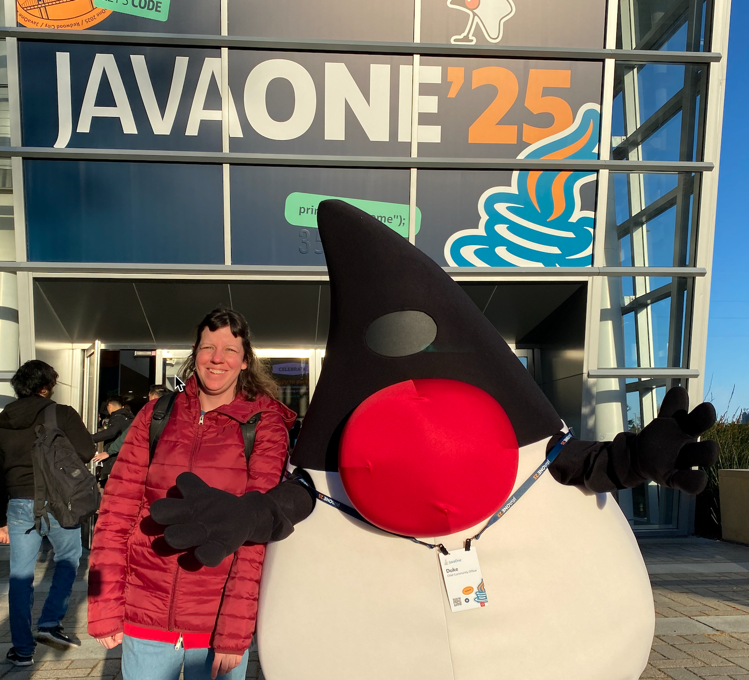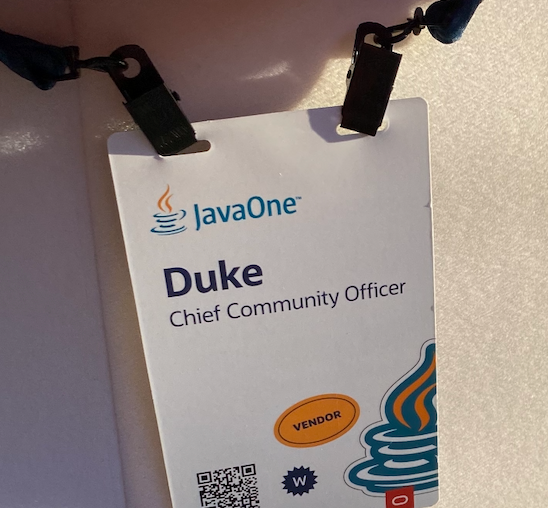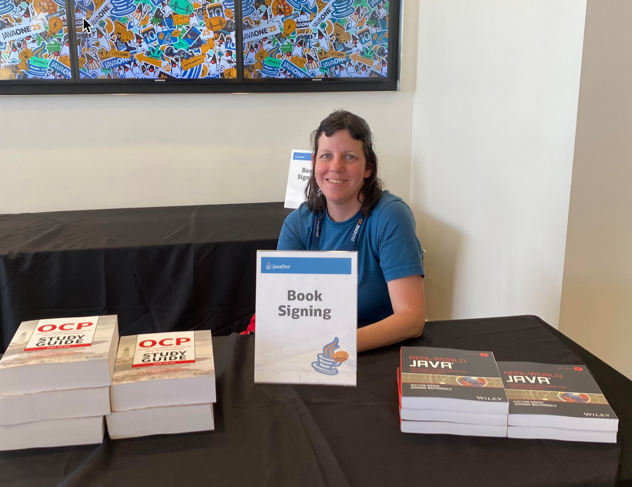See the table of contents for more posts
Chad Arimura
Started with history including pictures from the first JavaOne in 1996 and what Duke looked like then. Fast forward to present day. Java 24 launched this morning
Scott McNealty (retired but was here for the beginning) and Colt McNealy (Scott’s son)
Scott’s reminisced about the start of Java. Were originally planning on making a clicker. Never did but did better. Talked about licensing stuff to companies for a fee. Virtualization; creating a mess.
In the background was Fortune magazine’s JavaMan cartoon of Scott McNealy needing to stop Bill Gates from dominating the corporate universe.
Colt took AP computer science, went to Stamford and then got a real job. Real word harder than college where everything runs on one laptop. Created open source Lighthouse to get insights into threads, etc
Georges Saab
- 94 of Fortune 100 run Java
- Small companies use Java too
- ex: Uber, Netflix, LinkedIn
- 6 billion java cars deployed each year – ex: smartphones have two Java parts, credit cards, RFID cards, car
- 15 releases under 6 month cadeence (since Java 10)
Mark Cavage
- “crazy Mark” to disambiguate which Mark (vs Mark Reinhold). “Crazy” because proposed six month cadence
- Now at Docker
- 8M Java developers on Docker
- Can run LLMs natively in Docker: docker model run ai/llama3.2:1b
Georges Saab
- Not every change gets a JEP
- Read release notes
- Performance
Mingmin Chen (Head of Uber’s real time search platform)
- Asked how many people used Uber in last 30 days. It was almost everyone.
- Use Kafka, Flink, Pinot, judi, spark, presto, open search
- Generational ZGC to reduce memory usage. Also reduced CPU
Georges Saab
AI
- code generation/assistance
- model integration for business apps (langchain4j)
- model training (panama, valhalla, babylon)
New learners
- simple source files
- instance main methods
- single/multi file source code launcher
- script ready shebang upport
Missed name but someone from College Board and also Heather Stevens
- AP Computer Science A being revised in Fall 2025 from Java 8
- Encouraging teachers each year to use latest version of java
- Exam has used Java for 0ver 20 years [I took it when Pascal and C++)
- A third of schools with one AP class have Computer Science A
Mark Reinhold
- Developer vs steward
- Reading is more important than writing
- Simplicity matters
- Java should be one language with the same meaning everywhere
- Java has never been about write once and throwaway code. [that’s what vibe coding is I think?]
- “first do no harm”
- Compatibility – source, binary, behavioral, migration, intellectual (build on existing knowledge)
- Project Amber “paving the on ramp”.
JEPS 494 and 495 with more to come
- Showed evolving the classic Hello World to use an instance main, removing the args, removing class declaration, import so can write println(). Final form is
1 2 3 | void main() { println("Hello World!"); } |
- import module java.base; to import everything in module in one shot
- chmod +x fileName; ./fileName to run
Garbage Collection
- Compared garbage collectors. ZGC from Java 15 is extremely low latency..
- In Java 17, got to sub millisecond pause times.
- ZGC doesn’t scale well . Fixed in Java 21 by making generational
- Still need multiple garbage collectors because GC uses a lot of memory.
- Java 24 – improved latency in Parallel an G1 garbage collectors
Paul Bakker (Netflix)
- Use GraphQL, Spring Boot, Kafka, gRPC, cassandra, etc
- Had client timeouts from pause times. Switched to ZGC and saw no pause times so clients have less errors
Mark Reinhold
Project Leyden
- improve startup time
- Move work earlier or later
- Goal is to avoid new contrainst on existing code, without changing spec and without making Java less dynamic
- Instead use training runs
- Training: java -XX:AOTMode=record -XX:AOTConfiguration-app.aotconf…
- Assembly: java -XX:AOTMode=create -XX:AOTConfiguration-app.aotconf.-XX:AOTCache=-app.aot ….
- Execution: java -XX:AOTCache=-app.aot ….
- Can do a lot of work up front,. Too long to list. Ex: link classe (in Java 24) and more in future versions of Java
- Took about 30% of the original time before Leyden
Native libraries
- hard to use JNI by design
- Useful for crypto, ML, etc
- Project Panama add Foreign Function and Memory API. Use jextract to automatically generate bindings rom the C/C++ header file.
Paul Sandoz
- Function is code and weights
- Training computes the weights
- ONNX – open neural network exchange for ML. Includes interoperable format for ML models and runtime for executing them
- Use Panama and jextract to bind to onnx.h file
Mark Reinhold
More pain points
- Quantum computing will break RSA. Preparing with Key encapsulation, key derivation, quantum resistant mechanism/algorithms. Will eventually back port to past LTS releases.
- The stream API isn’t fully extensible. Java 24 stream gatherers
- My favorite bytecode library breaks on Java 21 – “stop using it” . Class file API
- Writing raw HTML in JavaDoc is tedious. Now can use markdown.
- You aren’t delivering new features quickly enough – integrity by default. Need to be able to refactor JDK internals. Deprecate/remove things not used
Bruno Borges and Mark Heckler (Microsoft)
- VS Code, (3 million monthly downloads) GitHub, Azure (95% of Fortune 500 customers)
- AI agent – create a plan, retrieve context, perform an action
- Nice demo of Copilot chat in VS Code. Also showed Codespaces
- Microsoft has 2.5 million JMVs running internally. Includes Minecraft, Bing, etc
- Minecraft uses Java 21
Chad Arimura
- dev.java – tutorials for latest features. Meant for professionals
- learn.java – new. For teachers and students
My take
I like that they covered a lot and quickly. Some things were interesting like the AP changes but only needed a few minutes to cover so it was great that is what they got. While the language parts weren’t new to me, it was well covered. Also nice Mark threw in a few cat pictures. I hadn’t heard of Project Leyden or GRPC along with some of the new features. And I wasn’t familiar with the native binding changes. Nice to learn a bunch of new stuff. It was nice to see a few demos as well



